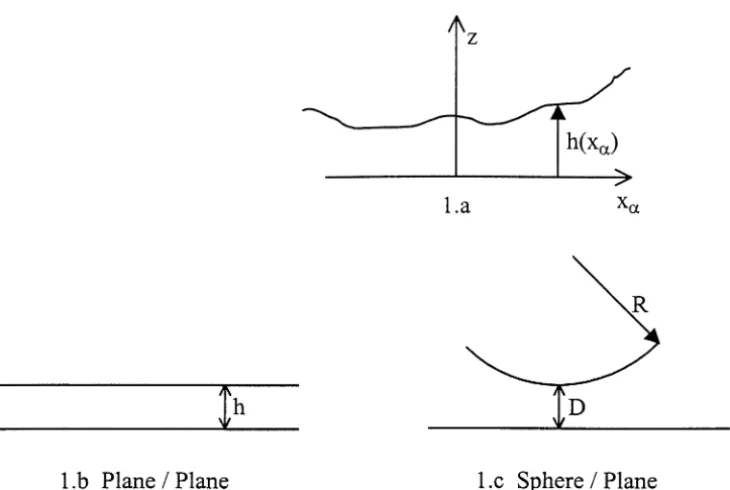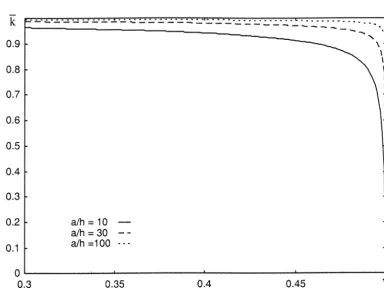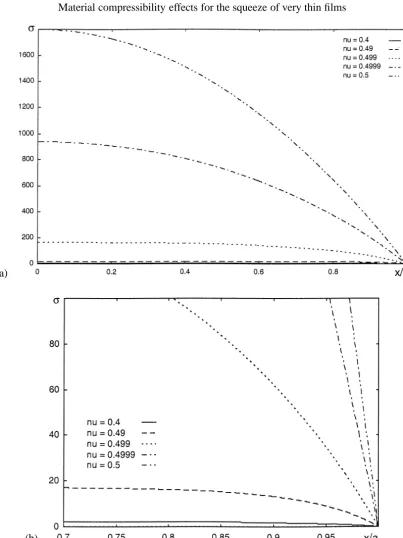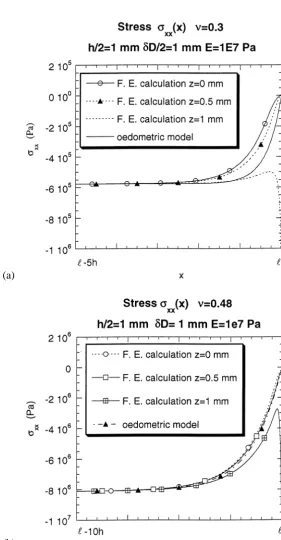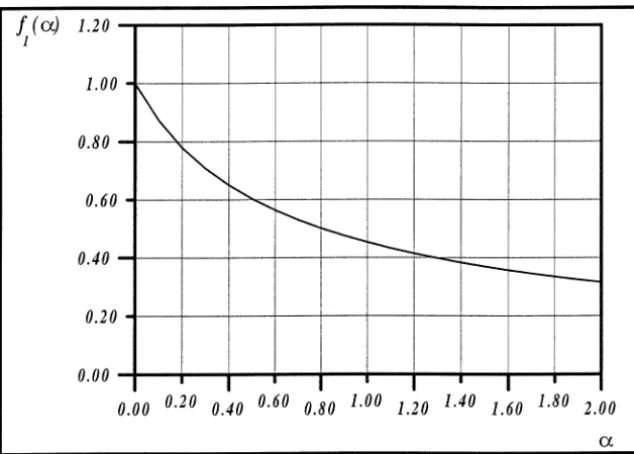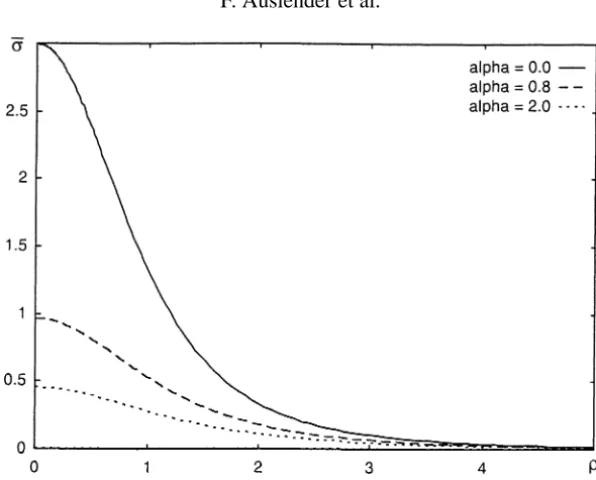Elsevier, Paris
Material compressibility effects for the squeeze of very thin films
François Auslender, Mohammed Trifa, François Sidoroff1
Laboratoire de Tribologie et Dynamique des Systèmes, UMR 5513, Ecole Centrale de Lyon, 69131 Ecully, France
(Received 26 May 1997; revised and accepted 23 February 1999)
Abstract – The purpose of the present work is the study and clarification of the essential role played by the material compressibility of very thin solid layers such as for instance appear in surface force experiments. For the sake of simplicity, attention will be focused on an elastic film squeezed between rigid surfaces. The starting point is the classical lubrication theory reformulated within the framework of linear elasticity (Incompressible Reynolds Model). This model is then extended to include compressibility effects. This extension is based on a phenomenological analysis of the stress and strain fields obtained in some simple model cases and which are shown to correspond to an oedometric squeeze inside the contact with boundary corrections. This results in the oedometric Reynolds model which is then applied to two special cases: a uniform film of constant thickness under plane strain condition and the interfacial film occurring in the sphere/plane contact. These two problems confirm the fact that compressibility cannot be neglected for very thin films and show that the governing adimensional parameters combine compressibility and thinness.Elsevier, Paris
thin films / squeeze / nanorheology / compressibility
1. Introduction
The mechanics of very thin layers is an important field in many scientific or engineering problems. The starting point of the work which will be presented here is essentially related to the nanorheological analysis of confined liquid layers as it appears in surface force apparatus (Israelachvili, 1992; Tonck et al., 1988). Experimental evidence as well as physical understanding clearly show a solid like structuration of the liquid near the walls requiring, for a correct mechanical interpretation of the experimental results, refinement of the usual models (Chan and Horn, 1985; Monfort and Hadziioannou, 1988) in order to take into account the heterogeneous structure of the interfacial film as well as a significant understanding of the influence of the involved material parameters. Such an analysis has been presented in (Sidoroff and Auslender, 1996; Auslender, 1996) which was essentially based on an extension of Reynolds equation to an heterogeneous viscoelastic film under harmonic solicitation. When compared with experiments, this analysis provided a qualitatively correct picture but required for the confined solid like layer an elastic stiffness much smaller (several orders of magnitude in fact) than the values which could reasonably be expected.
The explanation advanced for this discrepancy was the fact that the proposed analysis assumed incompress-ibility. It remains however (i) to develop a proper extension of the mechanical model to the compressible case and (ii) to understand how material compressibility can play such an important role for this kind of problem whereas it can reasonably be neglected for so many other problems.
These are in fact the essential issues to be dealt with in the present paper. For the sake of clarity, we will focus on a very simple problem: the squeeze of an homogeneous or heterogeneous thin linear elastic film between two rigid bodies. Extension to the practical situation investigated in (Tonck et al., 1988; Monfort et al., 1991;
Georges et al., 1993) (viscoelastic harmonic response) is however straightforward through the use of complex harmonic variables and responses. More generally, it is believed that the physical insight to be gained can be used for many other problems, in particular connected with interfaces in composite materials and structures.
2. General background
2.1. Formulation of the squeeze problem
Let us consider a thin elastic film confined between two rigid bodies respectively defined in the natural reference configuration by z=x3=0 and z=h(xα) (Greek indices α, β take the values 1, 2 while Latin indices i, j take the values 1, 2, 3 with the usual summation convention). Denoting by u the displacement field, the boundary conditions for the squeeze problem are
uα=u3=0 forz=0,
(1) uα=0, u3=δD forz=h(xα)
to be completed with free boundary conditions at infinity or on the outer lateral surface. HereδDdenotes the prescribed vertical displacement.
In particular, we shall be interested in the global squeeze stiffnessk
F =kδD, F =
Z Z
z=0
σ33dS. (2)
Special attention will be focused on the plane/plane case (figure 1b)
h(xα)=h=cte (3)
and on the sphere/plane case (figure 1c)
h(r)=D+ r
2
2R, (4)
whereDis the sphere plane separation andR the sphere radius.
2.2. Elastic formulation of Reynolds equation
Lubrication theory and Reynolds equation (Cameron, 1967) are usually developed in fluid mechanics from Stokes equations. From a formal point of view these equations are identical with Navier’s equations in linear elasticity with the correspondence velocity → displacement and strain rate → strain. The Reynolds approximation can be developed just as well in elasticity and it appears as the appropriate model for the analysis of very thin elastic or viscoelastic layer.
The investigated elastic problem for an incompressible layer is formulated as follows
divσ=0, (5)
εii=0, (6)
σ= −p1+2Gε (7)
Figure 1. The squeeze problem. 1.a General case; 1.b The plane/plane case; 1.c The sphere/plane case.
Integrating ∂uz/∂zas given by (6) with respect toz and using the boundary conditions (1), the following “flow equation” is obtained
−divq= −∂qα ∂xα =
δD withqα=
Z h(xα)
0
uαdz. (8)
Classical lubrication theory (Cameron, 1967) is essentially based on the following assumptions: (a) the hydrostatic pressurepdoes not depend onz,
(b) the terms∂uα/∂zare prevailing in the expression of the strain tensor.
Using these two assumptions, the equilibrium equations (5) can be integrated once with respect toz
∂uα ∂z =
1 G
∂p
∂xα
z+cte
. (9)
Further integration of these relations combined with the boundary conditions (1) will provideuα and finally q as
q= − h
3
12Ggrad(p) (10)
for an homogeneous material.
This equation can be interpreted as a ‘constitutive equation’ relating q to the pressure gradient grad(p), and which combined with the flow equation (8) leads to the classical Reynolds equation
div
h3
12Ggrad(p)
Application to the sphere/plane problem (4) gives
p(r)= −3GRδD
h2 , F =2π
Z ∞
0
p(r)rdr= −6π GR
2
D δD. (12)
Strictly speaking the integral in (12) should be from 0 tor∞, radius of the outer lateral surface, but it can be shown that this correction is usually very small. These expressions correspond to the standard Chan and Horn solution, classically used for the analysis of surface force results (Chan and Horn, 1985) either directly or in a straightforward viscoelastic extension. Henceforth, this elastic formulation of the lubrication theory will be referred to as the Incompressible Model.
Similarly application to the plane/plane problem (3) under plane strain condition directly results in
p= −2EδD h3 (a
2
−x2) (13)
for a thin plane of length 2ain thex1=xdirection and of widthLin thex2direction witha≪L.
2.3. The compressible case
For an isotropic compressible elastic material the constitutive equation (6), (7) has to be replaced with
σ=σkk/3=Kεkk, (14)
sij=2Geij, (15)
whereσ is the hydrostatic stress,sij andeij the deviatoric stress and strain tensors, whileKandGare the bulk and shear elastic modulus which will be considered as constant in the homogeneous case but may also depend onxα andzin case of heterogeneous film.
Integration of the nonvanishing volumetric strainεiithen leads to a modified expression for the flow equation
Z h(xα)
0
εiidz=div q+δD6=0, (16)
whereεiiis now given by (14). Further treatment of this equation however requires a better knowledge of the stress tensor structure. To reach this knowledge some simple problems will now be considered.
3. The plane/plane problem
Let us first consider the plane/plane problem already investigated in the incompressible case (13). A symmetric formulation of the corresponding plane strain boundary value problem is
z= ±h/2: ux=0, uz= ±δD/2,
3.1. Variational methods
The variational theorems in linear elasticity (Germain, 1986) give an estimation of the potential and complementary energy of the exact solution(σij, ui)through
H σbij
6H (σij)=K(ui)6K uei
. (18)
The potential energyK(uei)of the kinematically admissible displacement fielduei is
K uei
wherefi andTid respectively denote the body forces and given surface forces onSf (herex= ±a). Similarly the complementary energyH (σbij)of the statically admissible stress fieldσbij is
H σbij
i denotes the prescribed displacement onSu(herez= ±h/2).
For the plane/plane problem (17) the body forces fi and the applied surface forces Ti =(σxz, σxz) on the boundaries x= ±a vanish. The only non vanishing data is the displacement uz= ±δD/2 on the boundaries z= ±h/2. Accordingly
so that the basic inequality (18) becomes
H σbij
Any kinematically [resp. statically] admissible field will provide an upper [resp. lower] boundk˜ [resp.k] of theˆ contact stiffnesskintroduced in (2).
The kinematically admissible displacement field
e
ux=uey=0, uez=δD z
h (22)
describes the “oedometric” (without lateral motion) squeeze of the film. The corresponding upper boundk˜ is obtained from (19) as
˜
whereλ, µare the usual Lamé elastic constants.
(a1< a) and by correcting it near the edgesx= ±a in order to satisfy equilibrium and the stress boundary
conditions (17). This can be achieved through the following Airy function
φ(x, z)= − 6q0
whereθ=(a−a1)/ h. The corresponding lower bound is after some computations obtained from (20) as
ˆ
The evaluation of course depends ona1, and the next step would be to chooseθ to maximise this lower bound
and therefore to obtain the optimal size of the considered edge effect. This is however not necessary for the present purpose which is the thin film limith/a→0. Indeed ifθ is chosen of order of O(1), the combination of these two estimations results in
ˆ
k=k∞ 1−O(h/a)6k6k˜=k∞= 2E(1−ν) (1−2ν)(1+ν)
La
h . (26)
This value (23) of the contact stiffnessk∞is the thin film limit for any valueν <1/2.
3.2. Discussion
The evaluation obtained in (26) clearly shows the validity of the oedometric approximation k∞ for very thin films. However if this limit is obtained for any valueν <1/2 of the Poisson ratio, it does not hold at the incompressible limitν→1/2. This is for instance clear on (23) from the(1−2ν)term in the denominator.
These two limits, thin film and weak compressibility, do not commute. More precisely
lim
where the second limit has been obtained from Reynolds approximation. We have no proof for that but it is probably true.
The above approximations can be improved through a better choice and optimisation of the kinematically and statically admissible fields (Auslender et al., 1995; Armengaud et al., 1995). For instance the following kinematically admissible field
combines the squeeze (22) with the horizontal displacement observed in Reynolds approximation. Heregis an arbitrary function (withg(0)=0) which will now be chosen in such a way to minimise the potential energy K=W. After some computation
withξ=xa, d=158ha22, b=
Minimisation of this integral with respect to the function gis a standard variational problem resulting in a second order differential equation
cg(ξ )−dg′′(ξ )=0,
g(0)=0, dg′(1)+b=0.
The solution is readily found as
G
Finally, substituting this function in (28), an improved upper bound of the stiffness is obtained
˜
Again the singular incompressible limit(ν→1/2)is encountered adimensional parameter√1−2νa/ h. A similar and more complex analysis can also be performed to improve the lower bound (Armengaud et al., 1995).
Asymptotic methods (Sanchez-Palencia and Sanchez-Hubert, 1992) can also be used for the thin film limit ε=h/a→0. However in this particular case, they do not provide any further information with respect to the variational methods discussed above. Indeed the first order outer solution is found to coincide with the oedometric solution. However, since this solution does not satisfy the boundary solution onx= ±a, it has to be completed by an inner solution near these boundaries. The classical techniques used for extracting the inner solution (Sanchez-Palencia and Sanchez-Hubert, 1992) unfortunately result in the complete Navier problem. Asymptotic methods therefore only confirm the essential phenomenology of this problem: the oedometric solution holds true inside the contact and has to be corrected near the edges to account for boundary effects. The influence of these edge effects on the global response of the system however may be neglected for very thin layer, as follows from the upper and lower bounds (26).
4. Axisymmetric problems
4.1. Axisymmetric plane/plane problem
The results obtained in Section 3 can be extended to other more realistic geometries. As a first example let us consider the axisymmetric squeeze of a circular plate of constant thicknesshand radiusa. The corresponding boundary conditions are, in cylindrical coordinates,
The kinematically admissible oedometric displacement field is
e
ur(r, z)=0 euz(r, z)= δD
h z (32)
and the associated upper bound for the stiffness is given by
˜
k= E(1−ν)
(1+ν)(1−2ν) π a2
h =k∞. (33)
The corresponding uniform oedometric stress state is
σrra =σθ θa = ν
which do not satisfy the free boundary conditions (31) forr =a. A statically admissible stress field can then be constructed by connecting this oedometric state inside the contact(r < a1=a−θ h)to the boundaryr=a.
The connecting stress fieldσb, which must satisfy equilibrium, the boundary conditions (31) and continuity withσaonr=a1, can be taken as
The associated stiffness is then
ˆ
Finally and after some computation, the correcting terms can be estimated, resulting in the following evaluation for the stiffnessk
ˆ
which is an obvious extension of the result obtained in Section 3. Again the oedometric solution appears as the appropriate approximation for thin layers and the incompressible limit is singular.
4.2. The sphere/plane problem
Using standard asymptotic techniques the following reduced variables are introduced
With these variables, Navier equations are obtained as
ε2(λ+2µ)
Substituting the outer asymptotic expansion
v(ρ , t)=v0(ρ , t)+εv1(ρ , t)+ε2v2(ρ , t)+ · · · (41) in these equations directly gives the following problem at order 0
(
Equation (42) with the boundary conditions (43) directly gives the oedometric solution
vr0=0, vz0= t t1(ρ)
(45)
while the lateral boundary conditions (44) cannot be satisfied and therefore requires an inner development near the boundariesρ=ρ1. The corresponding boundary value problem cannot easily be solved but its contribution
will remain small because the corresponding oedometric stress rapidly decreases with increasingρ. The oedometric solution
e
ur(r, z)=0, uez(r, z)= δD
h(r)z (46)
5. Oedometric Reynolds model
5.1. Basic assumptions
From a qualitative point of view, the essential features of the displacement fields is clear: oedometric squeeze corrected by small lateral motion accounting for edge effects. To capture these features the assumptions (a) and (b) of the Reynolds model introduced in Section 2.2 are modified in
(a1) The vertical stressσ=σzzdoes not depend onz,
(a2) The horizontal strainεαβare negligible with respect toεzz, (b′) The terms∂uα/∂zare prevailing inεαz.
Assumptions (a1) and (a2) correspond to the oedometric squeeze while (b′) is a mere reformulation of
assumption (b).
It should be noted that these assumptions will result in a constant σzz and εαβ within the contact, which is consistent with static equilibrium and compatibility even in the case of an heterogeneous layered film.
Assumption (a2) with Hooke’s law (14) results in
σzz=σ=
Assumption (a2) and the oedometric relations (47) now allow evaluation of the left hand side of the
compressible flow equation (16)
Z h
Using assumption (a1) the modified flow equation is finally obtained as
σ h
Heterogeneity of the film can be taken into account by assuming K and G to depend onxα and z resulting inKoed(xα).
5.2. Modified flow equation
Combining assumption (b′) and the oedometric relation (47), the equilibrium equations require
∂
Integrating this equation twice with respect toz
whereτ0(xα)andu0(xα)are two integration constants which are obtained from the boundary conditions (1). A third integration with respect tozfinally provides, after some computations
q=Roedgrad(σzz), (50)
Combination of the two Eqs (48) and (50) gives the partial differential equation
σzzh Koed −
div Roedgrad(σzz)=δD. (51)
This equation defines the oedometric Reynolds model.
A much simpler form is obtained in the weakly compressible caseG/K≪1, ν∼1/2 for whichβ∼1 so that (51) becomes
This case is important for practical applications.
Similarly for an homogeneous layer, Eq. (51) simplifies into
σ h
6.1. The plane/plane problem
The plane/plane problem under plane strain condition, which has been analysed in Section 3 is now easily solved. Equation (53) becomes an ordinary differential equation which, with the boundary conditions σ (±a)=0 is readily solved as
Figure 2. Plane/plane problem. Evolution of the reduced stiffnessk/k∞as a function ofνforh/a=10,30 and 100.
which obviously tends to the oedometric limit (23) forh/a→0.
It can also be verified that for any fixed valuex this solution tends to the incompressible solution (13) when ν→1/2. Again these two limits: incompressibility ν→1/2 and thin film h/a→0, do not commute. The appropriate adimensional number for this problem is
α=a√1−2ν/ h (56)
which combines the film thinness with its compressibility. These results are exemplified in figures 2 and 3. As expected, this solution corresponds to the oedometric stress field inside the film corrected by a boundary layer near the edge
σ∼σ0
1−e−(a−l′x)
, where l′=h 2
s
2 3
ν
(1−2ν). (57)
This oedometric model is consistent with all the information gathered in Sections 3 and 4 about the solution of some simple problems. It therefore appears reasonable. It remains however empirical and requires further validation, in particular concerning the boundary layers which is the essential new feature it adds with respect to the simple oedometric approximation.
In order to check this validity some finite elements simulations have been performed. These simulations have been restricted to the boundary layers, i.e. on
(a)
(b)
Figure 3. Plane/plane problem. Evolution of the stress distribution for different values ofν.
(a)
(b)
Figure 5. Sphere/plane problem. Compressible correctionf (α)as function of the dimensionless parameterα=GR/KD.
the boundary layer effect essentially results from thisσxx component which must decrease from its oedometric value inside the contact to zero.)
A correct agreement is obtained except in the vicinity of the corner (z =h/2, x =a) where a stress singularity exists. The approximation also appears better for larger value ofν.
The axisymmetric plane/plane problem of Section 4.1 could be treated in the same way but no analytical solution appears available.
6.2. The sphere/plane problem
The axisymmetric problem now has to be solved withh(r) given by (4). An adimensional formulation is obtained by setting
r=√RDρ , δD1−ν
ν =DU , h¯=
h D =1+
ρ2
2 , σzz(ρ)= D
RU Gσzz(r). (58)
The differential equation (53) is
αhσ¯ zz− 1 ρ
d dρ
ρh¯
3
12 dσzz
dρ
=1, where α=1+ν 3ν
G K
R
D (59)
which has to be solved with the boundary conditionsσ→0, ρ→ρ∞orρ→ ∞.
The structure of (59) implies that the solutionσ (ρ)only depends on α. The normal force associated to the normal stressσ=σzzis then given by
F =6π GR
2δD
D
(1−ν)
ν f (α), where f (α)= 1 3
Z ρ∞
0
Figure 6. Sphere/plane problem. Reduced stress distributionσ h2/GRas a function ofρ=r√DRforα=0,0.8 and 2.0.
This expression for f has been normalised from the incompressible case (12) which corresponds to α=0 withf (0)=1. The relevant dimensionless parameterαclearly shows that compressibility cannot be neglected, even for nearly incompressible materials, i.e. for high values of the ratioK/G. Indeed this ratio appears inα as multiplied by the ratio D/R which, for thin layers, may be very small. The function f (α) is plotted in
figure 5. Typically a reduction by half of the force is obtained forα=0.8, i.e. if for instance ν=0.4999 for D/R=1.6 10−4. It should be noted that in the mentioned experiments (Tonck et al., 1988; Monfort et al., 1991;
Georges et al., 1993)D/Rtypically is of order 10−6.
In fact the limiting case of large α is probably more relevant. This corresponds to the oedometric approximation (46).
The corresponding adimensional stress distribution has been represented in figure 6 for different values ofα.
7. Conclusion
The influence of material compressibility has been investigated in the case of thin linear elastic films squeezed between two rigid bodies. Variational and asymptotic methods have provided estimations of the exact solution and understanding of the oedometric deformation mechanism. This essentially justifies the developed Oedometric Model approximation which appears as a reasonable description of the squeeze of very thin films. In this paper attention has been limited to the homogeneous elastic case but it should be noted that the developed Compressible Model is valid for heterogeneous layer and can easily be extended to the viscoelastic harmonic case by using complex quantities. This is now in progress for application to real tribological situations (Sidoroff and Auslender, 1996; Auslender, 1996).
compressibility) provides an interesting mathematical problem which, although encountered in other physical situations (like for instance layered metal-polymer composites), has apparently received little attention.
References
Armengaud G., Auslender F., Ségura J.M., Sidoroff F., 1995. Méthodes énergétiques appliquées à l’étude du comportement des couches minces élastiques. In: Actes du 12ème Congrès Français de Mécanique, Strasbourg, II, pp. 125–128.
Auslender F., 1996. Nanorhéologie des couches minces confinées. Thèse de l’Ecole Centrale de Lyon, no 96-42.
Auslender F., Armengaud G., Sidoroff F., Ségura J.M., 1995. Rôle de la compressibilité dans l’écrasement des couches minces. In: Actes du 12ème Congrès Français de Mécanique, Strasbourg, I, pp. 221–224.
Cameron A., 1967. The Principle of Lubrication. Wiley, New York.
Chan D.Y., Horn R.G., 1985. Drainage of thin liquid films. J. Chem. Phys. 83, 5311–5324.
Georges J.M., Millot S., Loubet J.L., Tonck A., Drainage of thin liquid films between relatively smooth surfaces. J. Chem. Phys. 98, 7345–7360. Germain P., 1986. Mécanique. Ellipses, Paris.
Israelachvili J.N., 1992. Intermolecular and Surfaces Forces. Academic Press, New York.
Monfort J.P., Hadziioannou G., 1988. Equilibrium and dynamic behaviour of thin films of a perfluorinated polyether. J. Chem. Phys. 88, 7187. Monfort J.P., Tonck A., Loubet J.L., Georges J.M., 1991. Microrheology of high polymer solutions. J. Polymer Sci. 29, 677–682.
Sanchez-Palencia E., Sanchez-Hubert J., 1992. Introduction aux méthodes asymptotiques et à l’homogénéisation. Masson, Paris.
Sidoroff F., Auslender F., 1996. Nanorheological behaviour of confined liquid layers for normal contact, The third body concept. In: Dawson D. et al. (Eds), Interpretation and Tribological Phenomena, Elsevier, Amsterdam, pp. 195–203.
